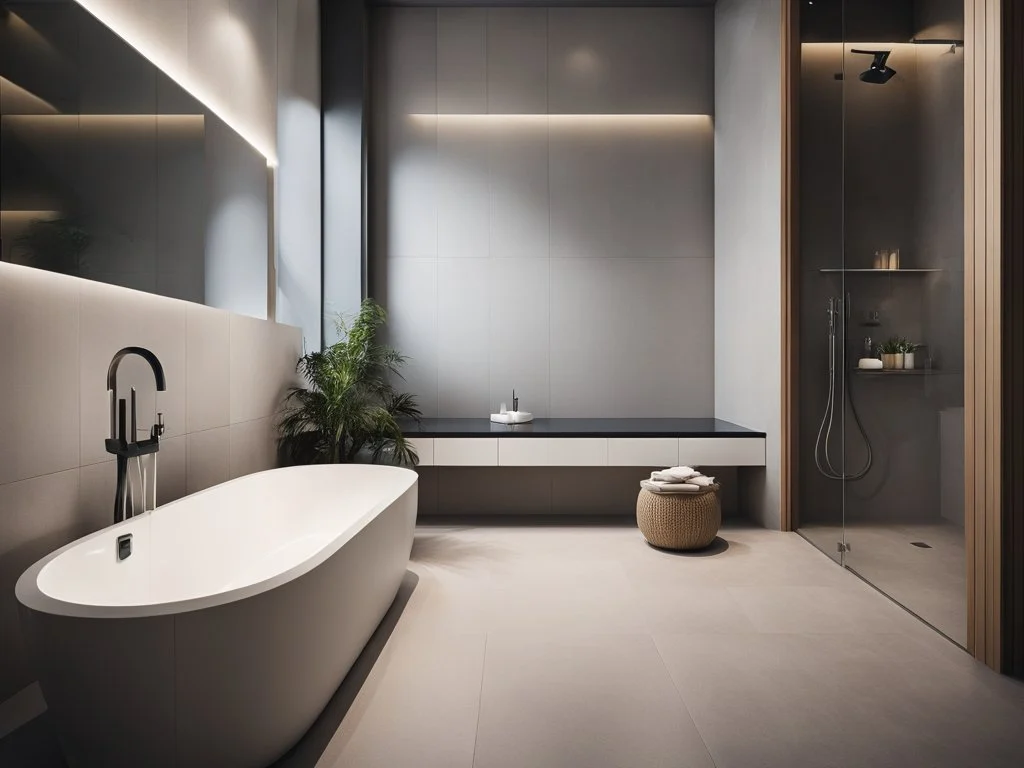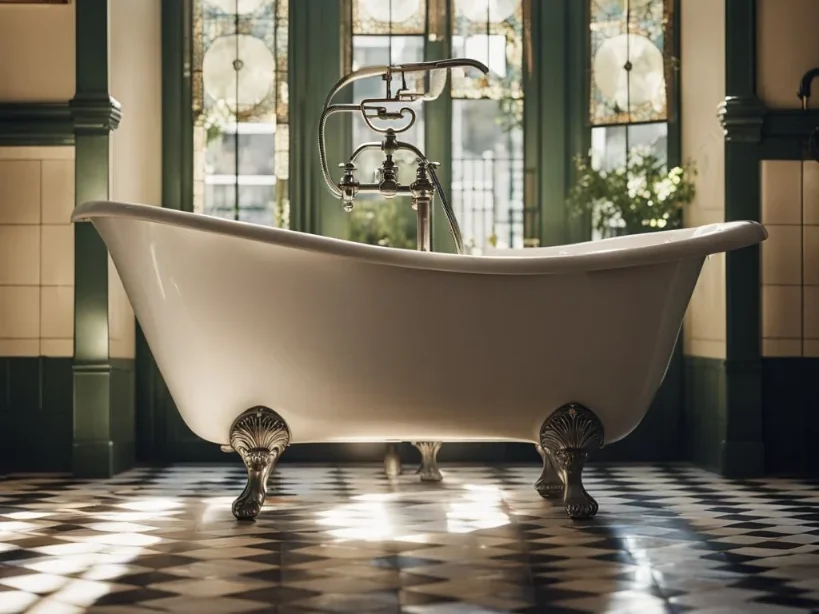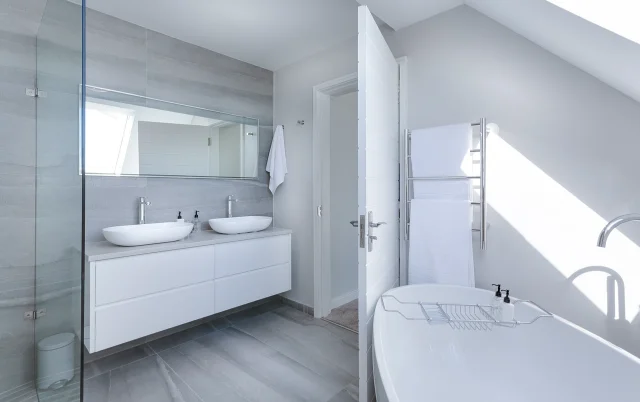Selecting the best bathtub material for your bathroom remodel involves understanding the wide range of options available and how each one aligns with your design preferences, practical needs, and budget. From classic cast iron to luxurious copper and natural stone, each material offers a unique set of characteristics that can enhance the comfort, style, and value of your bathroom. In this article, we delve into the various bathtub materials, considering factors such as aesthetics, weight, installation, durability, and maintenance, to help you make an informed choice that suits your lifestyle and decor.
Contents
- 1 Key Takeaways
- 2 Understanding Best Bathtub Materials
- 3 Factors to Consider When Selecting a Bathtub
- 4 The Impact of Bathtub Material on Price and Size
- 5 The Durability and Maintenance of Bathtub Surfaces
- 6 Conclusion
- 7 Frequently Asked Questions
- 7.1 What materials are bathtubs commonly made from?
- 7.2 What is the standard size of a bathtub?
- 7.3 What are some luxury bathtub materials?
- 7.4 How do bathtub materials affect the installation process?
- 7.5 What finishes are available for bathtubs?
- 7.6 How does the choice of bathtub material impact the overall cost?
Key Takeaways
- Acrylic and fiberglass bathtubs offer affordability and a wide range of design options, making them a popular choice for many homeowners.
- Cast iron tubs provide timeless elegance and durability but require sturdy floor support due to their weight.
- Luxury materials like copper, wood, and natural stone are high-end options that can serve as a bathroom’s centerpiece, though they come with a higher price tag.
- The material of the bathtub significantly affects both the initial cost and the long-term maintenance requirements, so choose wisely to balance upfront expenses with future upkeep.
- Consider the standard size and weight capacity of your bathroom floor when selecting a bathtub to ensure a seamless installation and avoid structural issues.

Understanding Best Bathtub Materials
Acrylic and Fiberglass Options
When considering a new bathtub, acrylic and fiberglass options stand out for their balance of affordability and durability. Acrylic tubs, made of clear plastic reinforced with fiberglass, offer a sleek appearance and are known for their durability. They are slightly pricier than their counterparts but provide a high load capacity and come in various finishes.
Fiberglass bathtubs are a budget-friendly choice, appreciated for their lightweight and ease of installation. However, they may not offer the same longevity as acrylic and can be more prone to scratches and wear over time.
Both materials are excellent for those seeking a modern look without breaking the bank, and they are often favored for their resistance to mildew compared to other materials.
Here’s a quick comparison of the two materials:
- Acrylic: More expensive, durable, higher load capacity, various finishes available.
- Fiberglass: More affordable, lightweight, easier to install, less durable over time.
We may earn commissions if you purchase from this link
The Classic Appeal of Cast Iron
Cast iron bathtubs exude a timeless elegance that can anchor the aesthetic of a bathroom. With their hardness and non-porosity, these tubs offer an extremely durable surface that is easy to clean and is resistant to stains, bacteria, and other microbes. Moreover, cast iron is renowned for its excellent heat retention, ensuring that your bath stays warm for the longest possible time.
When it comes to styles, cast iron tubs are versatile, available in modern, oriental, and traditional designs. They come in various sizes and custom finishes, allowing for a personalized touch in your bathroom. The iconic cast iron clawfoot tubs are not only beautiful but also incredibly sturdy, promising longevity that can span generations.
While cast iron bathtubs have some of the best positives over many bathtubs on the market, their significant weight is a factor to consider as it may not be ideal for all floor types.
Remember to learn how to care for your cast iron tub and, if applicable, how to install feet on your cast iron tub to ensure stability and add to its classic charm.
We may earn commissions if you purchase from this link
Luxury Choices: Copper, Wood, and Natural Stone
When it comes to creating a bathroom retreat that exudes luxury and opulence, materials like copper, wood, and natural stone stand out. Copper bathtubs are not only visually striking with their warm tones but also boast excellent heat retention. Over time, the material develops a unique patina, adding character to the bathroom space.
Wooden tubs offer an unparalleled organic aesthetic, often crafted from hardwoods for durability and waterproofing. However, the sophistication of wood comes with a higher cost. Natural stone tubs, carved from a single block of stone such as marble or granite, are the epitome of luxury. They are incredibly durable and serve as a stunning centerpiece.
Each of these materials, while offering distinct advantages, also requires consideration of weight and support. Copper and stone tubs are heavy and may necessitate reinforced flooring. Wood, while slightly lighter, still demands careful installation to ensure longevity.
It’s important to note that the choice of these materials can significantly influence the overall design and feel of a bathroom. They are often chosen by those looking to create a timeless design that remains stylish for years to come.
We may earn commissions if you purchase from this link
Innovative Solid Surface and Resin Tubs
Solid surface and resin bathtubs represent the cutting edge in bathtub design, offering a blend of aesthetics and functionality that is hard to match. These tubs are known for their versatility in style and form, accommodating a range of bathroom layouts and personal preferences.
Solid surface materials allow for a variety of tub shapes and sizes, from the compact 43” Japanese soaking tubs to expansive 75” double resin bathtubs. The material’s malleability means that whether you’re looking for a sleek, modern look or a double-ended tub with slopes at both ends, the options are plentiful.
The warmth and heat retention of solid surface tubs provide a prolonged, comfortable bathing experience without the constant need to add hot water.
When it comes to installation, these tubs can be paired with contemporary faucets for a modern bathroom aesthetic. Prices for solid surface freestanding tubs range broadly, making them accessible for various budgets.

Factors to Consider When Selecting a Bathtub
Aesthetics and Color Finishes
When selecting a bathtub, aesthetics play a crucial role in complementing the overall design of your bathroom. The variety of color finishes available allows for personalization and alignment with your style preferences. For instance, solid surface bathtubs offer an extensive palette ranging from classic glossy white to bold matte black, ensuring that there’s a perfect match for every decor.
The best materials for your bathtub-shower combo are acrylic for affordability and ease of maintenance, porcelain-enameled steel for durability, and tile for aesthetic versatility.
Moreover, the finish of your bathtub can impact both the visual appeal and the maintenance requirements. High gloss finishes are popular for their reflective quality and ease of cleaning, while matte finishes provide a contemporary look but may require more diligent care to maintain their appearance. Below is a list of common finishes for solid surface bathtubs:
- Glossy white
- Matte black
- Thunder gray
- Matte white
Additionally, coordinating the drain finish with your faucet can add a cohesive touch to your bathroom’s design. Options range from chrome to oil rubbed bronze, allowing for a seamless integration with the overall aesthetic.
Weight and Floor Support Requirements
When selecting a bathtub, it’s crucial to consider the weight and floor support requirements of the material. Acrylic bathtubs, for example, are relatively lightweight, with an average weight of around 90 to 130 pounds, making them easier to install and less demanding on floor supports. In contrast, cast iron tubs are significantly heavier, often weighing several hundred pounds, necessitating a thorough assessment of the floor’s structural integrity before installation.
The weight of the bathtub not only affects installation but also influences the overall bathroom design and the feasibility of placing the tub on upper floors.
For a clearer understanding, here’s a comparison of different bathtub materials and their typical weights:
| Material | Average Weight (lbs) |
|---|---|
| Acrylic | 90 – 130 |
| Cast Iron | 300 – 500 |
| Stone Resin | 379 – 972 |
Always consult with a professional to ensure that your floor can support the weight of your chosen bathtub, especially for heavier materials like stone resin, which can reach a full weight of nearly 1000 pounds when filled with water.
Installation Types and Plumbing Considerations
When selecting a bathtub, the installation type is a crucial factor to consider. Freestanding tubs, for example, offer a flexible installation process and can be a stylish focal point in the bathroom. However, if you’re considering replacing an alcove tub with a freestanding one, be prepared for potential plumbing reworks.
Plumbing alignment is key. Confirm that the plumbing will line up with your new tub, especially if you’re opting for a similar replacement. For different styles, adjustments may be necessary.
Understanding local code requirements is also vital. Plumbing codes can vary, and you may need permits for your bathroom remodel. Ensure that permit costs and code compliance are factored into your project budget. Rerouting or adding plumbing can add significant time and costs to the installation.
Here’s a quick checklist to guide you through the installation considerations:
- Check existing plumbing compatibility
- Note the existing drain location
- Consider the need for plumbing adjustments
- Verify code requirements and permit needs
- Discuss installation complexity and costs with a professional
The Impact of Bathtub Material on Price and Size
Budgeting for Bathtub Materials
When planning for a new bathtub, budgeting is a critical step. The material you choose not only affects the aesthetic and feel of your bathroom but also has a significant impact on the cost. Acrylic and fiberglass bathtubs are known for being lightweight and affordable, making them a popular choice for many homeowners.
On the other hand, materials like cast iron and copper offer a sense of durability and luxury but come with a higher price tag. It’s important to consider not just the initial cost but also the long-term value, as some materials may require less maintenance over time.
Size Ranges and Standard Dimensions
When selecting a bathtub, understanding the standard dimensions can help ensure a proper fit for your bathroom space. Bathtubs come in a variety of sizes, tailored to different bathroom layouts and user preferences. For instance, a typical freestanding bathtub may range from 55 to 72 inches in length and 27 to 32 inches in width.
The size of the bathtub you choose directly influences the comfort and functionality of your bathroom. It’s crucial to measure your available space and consider the tub’s external dimensions as well as the internal bathing well.
Here’s a quick reference for common bathtub types and their standard dimensions:
- Corner Bathtub: 60 inches (L) x 60 inches (W) x 22 inches (H)
- Freestanding Bathtub: 55 to 72 inches (L) x 27 to 32 inches (W)
Remember, these dimensions are guidelines and can vary by manufacturer. Always consult with a professional to ensure the best fit for your specific bathroom layout.
Comparing Price Points Across Different Materials
When selecting a bathtub, the material not only affects the aesthetics and durability but also the cost. Acrylic bathtubs are a popular choice due to their versatility and wide range of styles, typically ranging from $500 to $900+. Other materials can significantly vary in price, reflecting their quality and uniqueness.
Here’s a quick comparison of average costs for different bathtub materials:
| Material | Average Cost |
|---|---|
| Acrylic | $500 – $900+ |
| Fiberglass | $300 – $600 |
| Cast Iron | $500 – $2,000 |
| Copper | $2,000 – $5,000+ |
| Wood | $1,500 – $4,000 |
| Natural Stone | $2,000 – $10,000+ |
| Solid Surface | $1,000 – $3,000 |
| Resin | $1,200 – $2,500 |
While initial costs are important, consider the long-term value. Some materials may require more maintenance or may not last as long as others, potentially leading to additional expenses over time.
It’s crucial to balance the upfront cost with factors such as durability, maintenance, and the overall impact on your home’s value. Remember, investing in a higher-quality bathtub can enhance your daily experience and increase the resale value of your property.

The Durability and Maintenance of Bathtub Surfaces
Longevity of Different Bathtub Materials
The lifespan of a bathtub is a crucial consideration for homeowners. Acrylic and fiberglass tubs are popular for their affordability and versatility in design. However, they differ in longevity; acrylic bathtubs can last up to 30 years with proper care, while fiberglass options have a shorter lifespan, typically 10 to 15 years. Fiberglass is also prone to scratches and cracks, and may experience color fading over time.
When it comes to durability, materials like cast iron and copper stand out. Cast iron bathtubs are known for their long-lasting enamel coating and excellent heat retention, but they are significantly heavier and may require additional floor support. Copper tubs, while expensive, boast superior heat retention and develop a unique patina that adds to their appeal over time.
Choosing the right bathtub material is not just about aesthetics; it’s about finding a balance between durability, maintenance, and budget constraints.
For those seeking a balance between cost and longevity, consider the following materials ranked by their typical lifespan:
- Acrylic: Up to 30 years
- Cast Iron: Several decades
- Copper: Several decades with a developing patina
- Fiberglass: 10 to 15 years
Remember, the actual lifespan of your bathtub will depend on usage, maintenance, and the quality of installation.
Ease of Cleaning and Care
Maintaining the pristine condition of a bathtub is a key consideration for homeowners. The ease of cleaning is greatly influenced by the material of the bathtub. Non-porous surfaces such as those found in acrylic or mineral composite tubs allow for simple wipe-downs without the need for abrasive chemicals. Cast iron, known for its durability, also boasts a surface that resists stains and bacteria, making it relatively easy to maintain.
Regular maintenance is essential to keep your bathtub looking new. A routine cleaning process involves rinsing the tub with warm water, addressing grout and tile separately if present, and drying and polishing to prevent water spots.
Here are some steps to ensure a thorough clean:
- Rinse the bathtub after every use to minimize residue build-up.
- Use a non-abrasive cloth for drying and polishing the surface.
- Clean grout and tile with a mild cleaner and a small brush, like an old toothbrush.
Remember, while some materials may require more frequent care, proper upkeep can extend the life and appearance of any bathtub.
Repair and Refinishing Options
When it comes to maintaining the beauty and functionality of your bathtub, repair and refinishing are essential considerations. Over time, bathtubs may show signs of wear such as chips, scratches, or discoloration. Refinishing can restore the bathtub’s surface to a like-new condition, often at a fraction of the cost of replacement. There are several methods to achieve a rejuvenated finish, including enameling (spraying), acrylic bathtub liner installation, and pour-on application, each with its own set of advantages.
Bathtub refinishing is not only cost-effective but also environmentally friendly, as it reduces the need for complete tub replacement and the waste associated with it.
For homeowners, understanding the different refinishing options can help in making an informed decision. Here’s a brief overview of the methods:
- Enameling (spraying): A popular choice for its smooth, even white, and glossy coating.
- Acrylic bathtub liner installation: Offers a quick and less messy alternative.
- Pour-on application: Provides a durable and high-quality finish.
Each method requires careful preparation and skilled application to ensure the best results. It’s important to consult with professionals who can assess the condition of your bathtub and recommend the most suitable refinishing technique.
Conclusion
In conclusion, selecting the best bathtub material for your bathroom remodel is a crucial decision that impacts both aesthetics and functionality. From the classic durability of cast iron to the modern appeal of acrylic, and the luxurious touch of natural stone or copper, each material offers unique benefits. Consider factors such as weight, maintenance, installation, and budget when making your choice. Whether you opt for a wooden soaking tub as the epitome of luxury or a practical fiberglass option, ensure it complements your space and meets your needs. With the right bathtub, you can transform your bathroom into a personal oasis that reflects your style and provides the ultimate relaxation experience.
Frequently Asked Questions
What materials are bathtubs commonly made from?
Bathtubs are made from a variety of materials, including acrylic, fiberglass, cast iron, ceramic, copper, enameled steel, porcelain, resin, wood, concrete, and natural stone.
What is the standard size of a bathtub?
Standard bathtubs typically range in length from 50 inches to 72 inches, with widths from 30 inches to 42 inches, and heights from 14 inches to 24 inches. However, sizes can vary depending on the type and material of the tub.
What are some luxury bathtub materials?
Luxury bathtub materials include copper, wood, natural stone, and concrete. These materials provide a high-end look and are often more durable but may come with a higher price tag.
How do bathtub materials affect the installation process?
The material of a bathtub can impact the installation process, with heavier materials like cast iron and concrete potentially requiring additional floor support, and lighter materials like acrylic being easier to handle and install.
What finishes are available for bathtubs?
Bathtubs are commonly offered in white or off-white finishes, but they can also be found in a variety of colors such as blue, green, metallic, pink, purple, red, and yellow.
How does the choice of bathtub material impact the overall cost?
The choice of bathtub material greatly impacts the overall cost, with acrylic and fiberglass options generally being the most affordable, and materials like copper, wood, and natural stone being at the higher end of the price spectrum.


